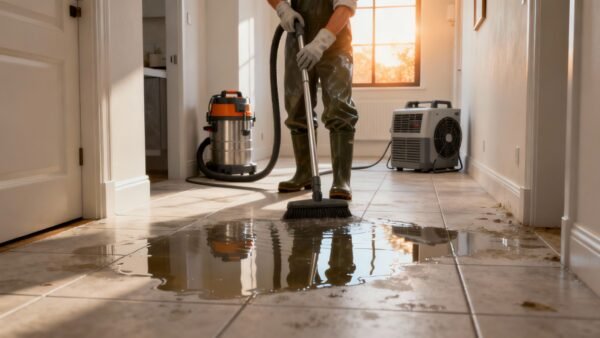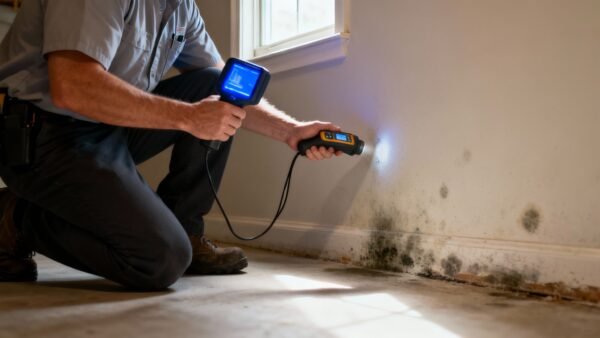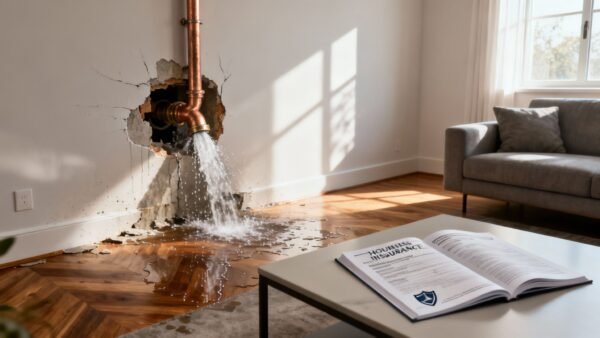Crawl space dehumidification is a critical process that uses a specialized machine to pull excess moisture out of the air under your home. This isn't just about making things less damp in your Van Nuys bungalow or Sherman Oaks property; it's about actively protecting your home's foundation and the air you breathe every day. For Los Angeles homeowners, getting this right is a huge step in preventing mold, wood rot, and unwanted pests from taking over the valuable space beneath your floors.
Contact Us for a Free Crawl Space Assessment
Why Crawl Space Dehumidification Is a Non-Negotiable for Your Home
Imagine a giant, soggy sponge sitting right under your house. That’s essentially what a damp crawl space is in places like the San Fernando Valley, where temperature swings can create condensation. It’s constantly releasing moisture, creating a humid, unhealthy environment that quietly wreaks havoc on your home’s structure. We’re talking about more than just a musty smell—this is about safeguarding your biggest investment.
What makes crawl space dehumidification so critical is a natural process called the "stack effect." Think of your house as a chimney. Air gets pulled up from the lowest point—your crawl space—and circulates into your living areas upstairs. If that crawl space air is damp, musty, and full of mold spores, that’s exactly what your family ends up breathing.
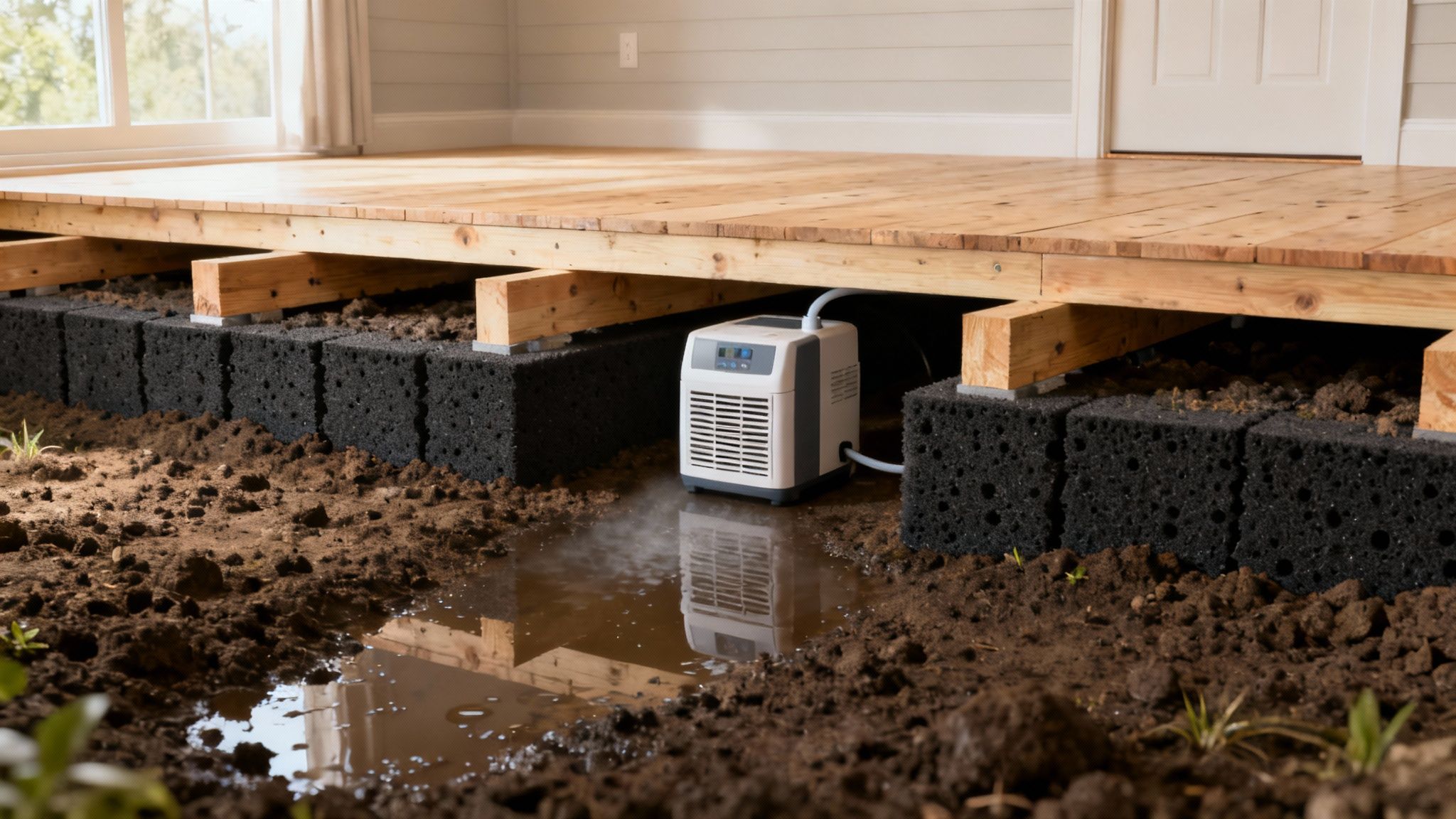
Protecting Your Investment and Your Health
Tackling that hidden humidity is one of the most important maintenance tasks you can perform as a homeowner. If you ignore it, you’re opening the door to some serious problems:
- Structural Damage: Persistent moisture is the mortal enemy of wood. It leads to rot in your floor joists and support beams, which can eventually cause your floors to sag. If you're already seeing signs, it may be time to look into solutions for crawl space water damage.
- Poor Indoor Air Quality: Mold, mildew, and dust mites thrive in damp, dark places. They release allergens and spores into the air that can trigger asthma, allergies, and other respiratory issues, a common concern for LA families.
- Pest Infestations: A damp crawl space is a five-star resort for termites, rodents, and cockroaches. Don't roll out the welcome mat for them.
Spotting the Red Flags
Not sure if you have a problem? It’s not always obvious, but your house will give you clues. Watch out for these common warning signs that your crawl space is holding too much moisture.
Top 5 Signs You Need Crawl Space Dehumidification
| Symptom | What It Looks Like | Why It's a Problem |
|---|---|---|
| Musty Odors | A persistent "damp earth" or mildew smell in your living areas that won't go away. | This is often the first sign of mold or mildew growth under the house. |
| High Indoor Humidity | Your home feels stuffy or clammy, windows have condensation, and wood doors stick. | Excess moisture from the crawl space is rising into your home via the stack effect. |
| Visible Mold or Mildew | You see fuzzy black, white, or green spots on joists, insulation, or the foundation walls. | Mold releases harmful spores that contaminate your indoor air and can cause health issues. |
| Buckling or Soft Floors | Hardwood floors start to cup or warp, or you notice soft, spongy spots in the subfloor. | The floor joists are absorbing moisture, causing them to weaken, rot, and lose integrity. |
| Pest Infestations | You're seeing an increase in pests like termites, spiders, cockroaches, or rodents. | Damp wood and soil create the perfect habitat for pests to breed and thrive. |
Seeing even one of these signs is a good reason to investigate further. According to the U.S. Environmental Protection Agency (EPA), controlling moisture is the key to controlling mold. The market for dehumidification systems reflects this urgency; a clear sign that people understand how crucial it is to control humidity in your house.
The Hidden Dangers of Crawl Space Moisture
That damp, musty smell coming from under your house? It's more than just an annoyance. It’s a warning sign of excess moisture—a silent threat that can slowly but surely jeopardize your home's structure and your family's health.
When humidity runs high in a crawl space, it creates the perfect breeding ground for all sorts of trouble. Ignoring it is a recipe for expensive repairs and persistent health issues down the road. This is why proactive moisture control, especially crawl space dehumidification, isn't just a nice-to-have; it's essential home maintenance.
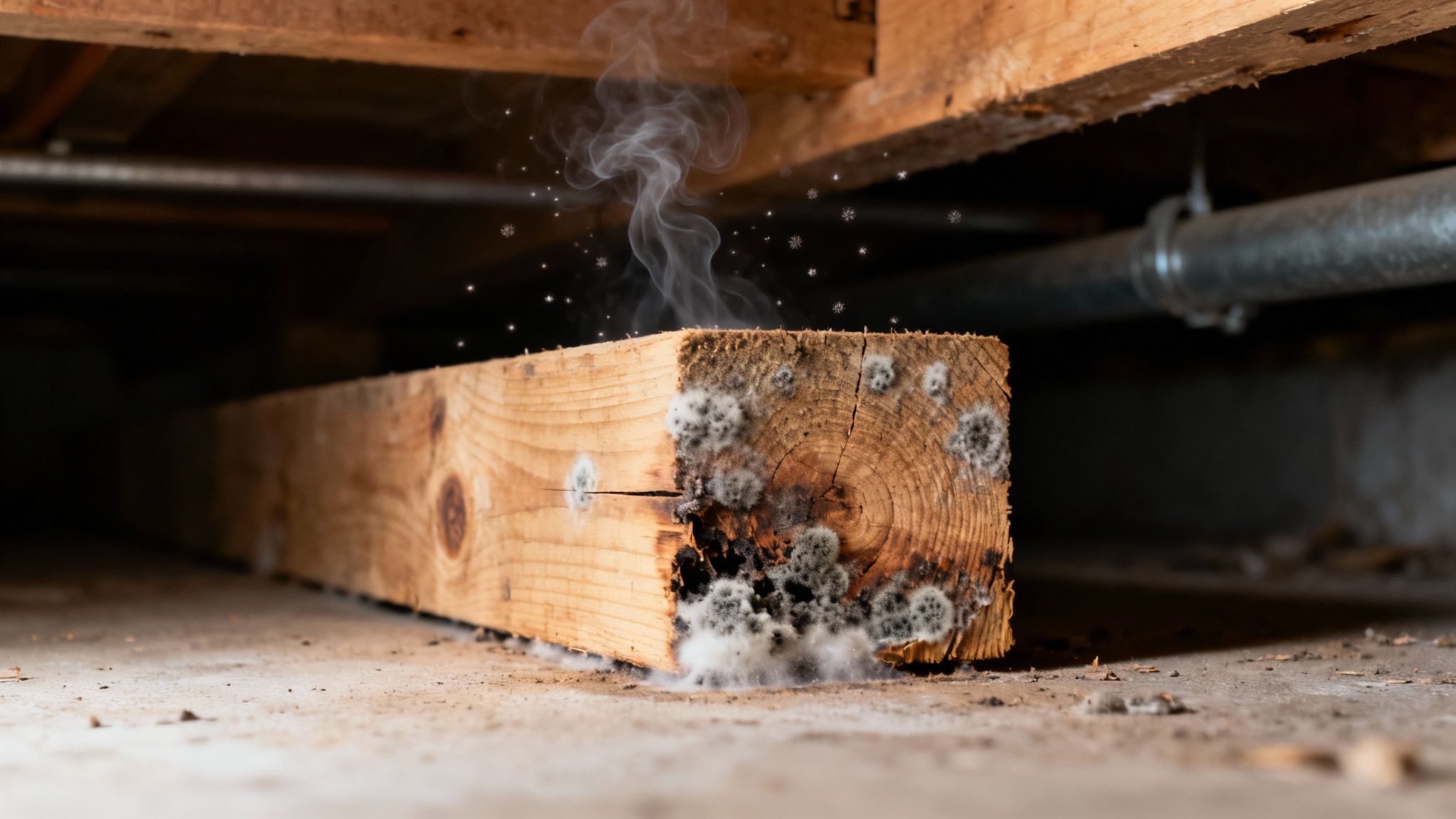
Unseen Structural Damage
Think of the wooden joists and beams holding up your floors like sponges. In a humid crawl space, they constantly absorb water vapor from the air. This constant saturation inevitably leads to wood rot, a type of fungal decay that literally eats away at the wood, turning it soft and weak.
Once that rot takes hold, the structural integrity of your home is on the line. The consequences are serious and get worse over time:
- Sagging Floors: Weakened joists start to bow under the weight of your home, causing floors to feel bouncy or uneven.
- Foundation Cracks: As support beams fail, the load shifts, putting immense stress on your foundation and causing cracks to appear.
- Corroded Metal: It’s not just wood at risk. All that moisture rusts out metal fasteners, plumbing pipes, and even your HVAC components.
Serious Health Risks
A dark, damp crawl space is a five-star resort for mold and mildew. These fungi release millions of microscopic spores into the air, and thanks to a natural airflow pattern called the "stack effect," those spores are pulled right up into your living areas.
That musty odor you smell is often the first clue. You're actually breathing in volatile organic compounds (VOCs) released by mold colonies. You can learn more about the dangers of hidden mold behind walls and other unseen spaces. If you suspect the air in your home is already compromised, getting professional air quality testing services can pinpoint the exact contaminants you're dealing with.
High humidity doesn't just stay in the crawl space. It directly impacts the air your family breathes every single day, often contributing to allergies, asthma flare-ups, and other persistent respiratory issues.
Pest Infestations
Pests are simple creatures; they're always on the hunt for food and moisture. A humid crawl space is like rolling out the welcome mat. Termites, carpenter ants, cockroaches, and even rodents are all drawn to these damp, dark environments.
These critters aren't just gross—they're destructive. Termites and carpenter ants will chew through your home's structural wood, adding insult to injury if you already have wood rot. Rodents will shred insulation for nesting and gnaw on electrical wiring, creating a serious fire hazard.
Keeping your crawl space dry makes your home a much less inviting target for these unwelcome guests.
How to Choose the Right Crawl Space Dehumidifier
Picking a dehumidifier for your crawl space is nothing like buying a regular appliance for your living room. The machine you choose has to be a workhorse, built to survive in a harsh, damp environment where you won't be checking on it every day. A standard household dehumidifier just won't cut it—it will fail quickly and won't be effective in the cool, moist conditions under your home.
This is why investing in a dedicated, commercial-grade unit is the only real option for successful crawl space dehumidification. These machines are built differently, with tougher components, corrosion-resistant coils, and powerful fans made for continuous, long-term operation. Yes, the upfront cost is higher, but their durability and performance will save you from constant replacements and the headache of uncontrolled moisture.
Key Features to Look For
When you start comparing models, you need to zero in on the specs that actually matter for a crawl space. Getting the right features means the unit will work smarter, not harder, keeping your energy bills down while properly protecting your home.
- High Capacity: The power of a dehumidifier is measured in pints per day (PPD). For a typical crawl space, you should be looking for a unit with a capacity of 70 PPD or more to stay ahead of the moisture.
- Low-Temperature Operation: Crawl spaces stay cool all year. A normal dehumidifier often freezes up and shuts down when the temperature drops below 60°F. A true crawl space model, however, is designed to keep working efficiently in temperatures as low as 40°F.
- Energy Efficiency: An Energy Star certified model isn't just a nice-to-have; it's a must. Since this machine will likely run 24/7, an efficient model can literally save you hundreds of dollars on your utility bills over its lifespan.
Understanding Drainage Options
Let's be realistic: nobody wants to crawl under their house to empty a bucket of water every day. That makes an automatic drainage system a non-negotiable feature.
A reliable, hands-off drainage solution is the most critical feature for any crawl space dehumidifier. The goal is set-it-and-forget-it operation, ensuring consistent humidity control without constant maintenance.
You’ve got two main ways to handle the water it collects:
- Gravity Drain: This is the simplest setup. A hose is attached, and the collected water flows downward and out of the crawl space. It’s effective, but it requires the dehumidifier to be elevated above wherever the drain exits.
- Condensate Pump: This is the far more versatile and common solution. An internal or external pump actively pushes the water out through a small tube. This gives you the flexibility to drain it uphill or over much longer distances, making it perfect for almost any crawl space layout.
It’s clear that homeowners are waking up to the risks of crawl space moisture. The same core principles of choosing a powerful, durable unit apply whether you’re tackling a crawl space or need effective basement dehumidification. To put the difference in perspective, here's a quick comparison between a standard dehumidifier and a professional crawl space unit.
Standard Dehumidifier vs Professional Crawl Space Unit
| Feature | Standard Dehumidifier | Crawl Space Dehumidifier |
|---|---|---|
| Durability | Plastic housing, designed for indoor use. | Steel or rotomolded plastic, built for harsh conditions. |
| Operating Temp | Shuts off or freezes below 60-65°F. | Operates effectively down to 40°F or lower. |
| Air Filtration | Basic, washable filter. | MERV-8 or higher filtration to capture mold spores and dust. |
| Drainage | Often relies on a gravity drain or manual bucket. | Integrated condensate pump for automatic, versatile drainage. |
| Installation | Plug-and-play, portable. | Professional installation recommended for optimal placement and drainage. |
| Lifespan | 2-5 years of typical use. | 10+ years of continuous, heavy-duty operation. |
As you can see, a standard unit is simply outmatched. It's not built for the unique challenges of a crawl space and will ultimately fail, leaving your home's structure vulnerable. Opting for a professional-grade machine isn't just an upgrade—it's a necessity for long-term protection.
Why Encapsulation Is Key to Dehumidifier Success
Just sticking a dehumidifier in an open, vented crawl space is like trying to air condition your Los Angeles home with all the windows wide open. You're fighting a losing battle against the outside air and the damp ground. For a dehumidifier to actually work, it needs to be part of a complete moisture control system—and that system always starts with encapsulation.
Think of it this way: encapsulation isolates your crawl space from the two biggest moisture culprits—the earth below and the humid air outside. Without sealing off the space first, your dehumidifier is forced to run 24/7, trying to dry out an area that’s constantly getting soaked again. This just leads to sky-high energy bills and a burnt-out machine.
Creating a Controlled Environment
The whole point of encapsulation is to create a clean, dry, and totally sealed environment. It transforms your musty, dirt-floored crawl space into a conditioned part of your home, which finally lets the dehumidifier do its job efficiently.
It’s a straightforward process with a few critical steps:
- Seal All Vents and Air Leaks: First things first, we block off all the outside vents and seal any gaps in the foundation. This stops humid, unfiltered air from getting in.
- Install a Heavy-Duty Vapor Barrier: Next, a thick, puncture-resistant plastic liner goes down over the entire crawl space floor and up the foundation walls. This completely stops moisture from the ground from evaporating into the air.
- Insulate the Walls: Often, rigid foam insulation is added to the walls. This helps manage the temperature and prevents condensation from forming on the cool foundation surfaces.
Once the space is sealed, choosing the right machine is the next step. This infographic breaks down what to look for in a crawl space dehumidifier.
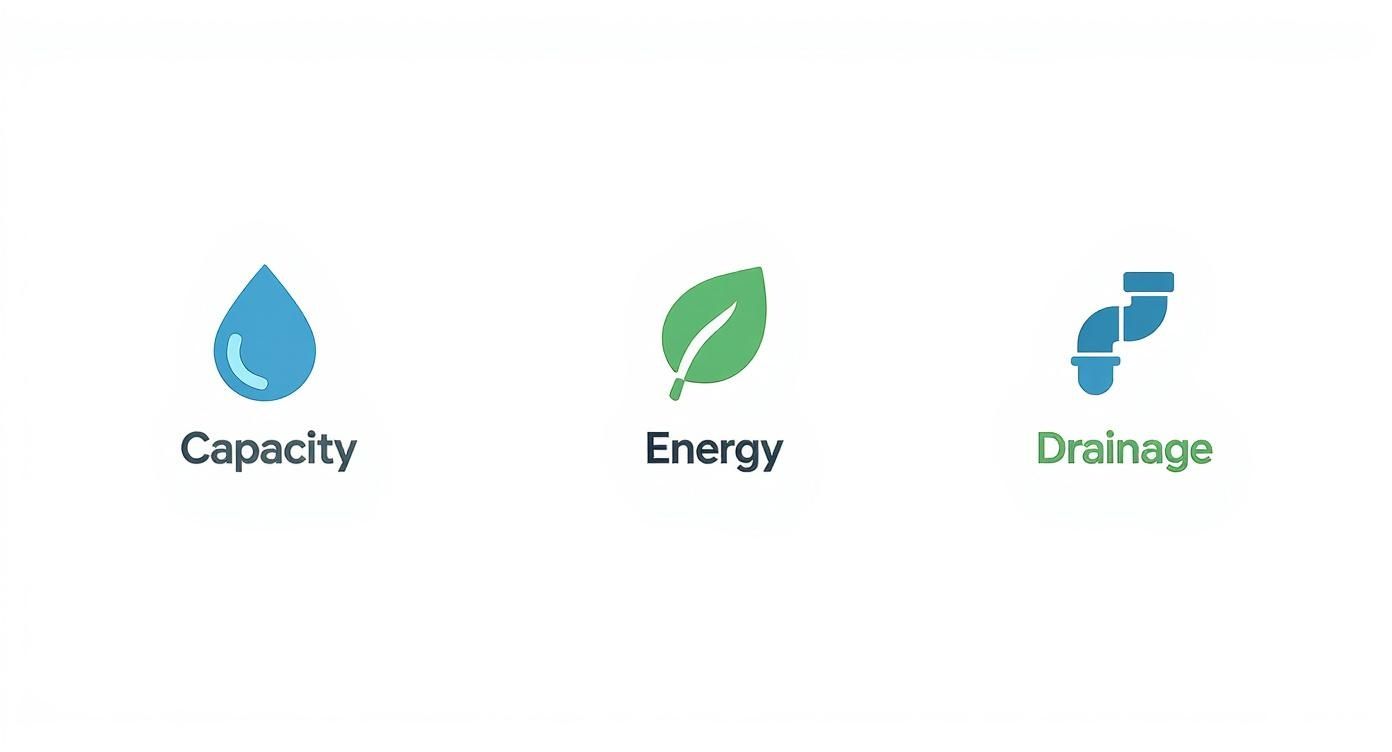
By focusing on the right capacity, energy efficiency, and drainage setup, you can make sure the unit is a perfect match for your newly encapsulated space.
Encapsulation and dehumidification are a team. One creates the stable environment, and the other maintains it. Together, they get results that neither could ever achieve on its own.
With the crawl space sealed tight, the dehumidifier can easily maintain the ideal humidity level, usually somewhere between 45% and 55%, without having to fight the great outdoors. This not only protects your home’s structure from rot and decay but also makes the air healthier throughout your entire house. And if years of dampness have already allowed mold to grow, encapsulation is a non-negotiable part of any legitimate crawl space mold removal in Los Angeles strategy.
DIY Installation vs Professional Services
Deciding whether to install a crawl space dehumidifier yourself or call in a professional is a major fork in the road. On one hand, a DIY project looks like an easy way to save some cash. But this is one of those jobs where a small mistake can create a much bigger, more expensive disaster down the line.
The Realities of a DIY Project
A true crawl space dehumidification setup is a lot more than just plugging in a machine. You'll need the right tools, but more importantly, you need to be willing to work in a cramped, grimy space. It also demands a real understanding of both electrical wiring and how to properly set up a drainage line that won't fail.
Get the setup wrong, and the system is useless at best. A poorly placed unit won't move enough air, leaving damp spots untouched. Even worse, a botched drainage line could lead to pooling water right next to your foundation, completely defeating the purpose. If a small mistake leads to a big leak, you could suddenly be searching for an emergency water damage restoration service near me—turning that "cost-saving" project into a serious financial headache.
Why a Professional System Is a Smarter Investment
Bringing in the pros is about getting it done right the first time, with no guesswork. An experienced technician isn't just installing a dehumidifier; they're designing a complete moisture control system. This often means pairing encapsulation with a perfectly sized and placed unit for peak efficiency.
A professional installation isn’t just about placing a machine; it’s about engineering a permanent solution to protect your home's foundation and air quality.
Experts also use commercial-grade equipment and materials that are built to last far longer than anything you can buy at a big-box store. They ensure the electrical work is safe and to code, and that the drainage system is foolproof. And maybe the most important part? Their work is almost always backed by a warranty, giving you a guarantee that protects your investment for years to come.
Common Questions About Crawl Space Dehumidifiers
Getting clear answers is the best way to feel confident you're making the right move to protect your home. Here are some of the most common questions Los Angeles homeowners ask about crawl space dehumidification.
What is the ideal humidity level for a crawl space?
The ideal relative humidity for a crawl space is between 45% and 55%. This is the sweet spot—dry enough to stop mold growth and wood rot in their tracks, but not so dry that it creates other problems for your home's wood framing. A professional dehumidifier with a built-in humidistat will automatically maintain this level for you.
How much does a crawl space dehumidifier cost to run?
The cost depends on the unit's efficiency, how much it needs to run, and local electricity rates (like those from LADWP). For a properly encapsulated crawl space, a high-efficiency, Energy Star-certified unit will typically add about $30 to $50 a month to your utility bill. This is a small investment to safeguard your home’s foundation.
Do I still need a dehumidifier if my crawl space is encapsulated?
Yes, absolutely. Encapsulation is crucial for blocking moisture from the ground and outside air, but it can't remove the humidity already trapped inside. A dehumidifier actively conditions the air within the sealed space, making them an essential team for a lasting solution.
How often does a crawl space dehumidifier need maintenance?
Professional-grade units are low-maintenance. The main task is to check and clean the air filter every six months to a year, much like your HVAC system. This ensures the machine runs efficiently. If your unit has a condensate pump, a quick annual check to ensure the drain line is clear is also recommended.
Ready to stop worrying about what’s happening under your floors? The team at Onsite Pro Restoration provides expert crawl space dehumidification and encapsulation services to protect your Los Angeles home from moisture, mold, and pests. Contact us today for a free assessment!


